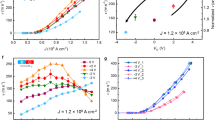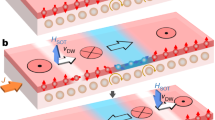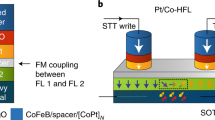Abstract
Electrical control of magnetism has the potential to bring about revolutionary new spintronic devices1,2,3,4,5, many of which rely on efficient manipulation of magnetic domain walls in ferromagnetic nanowires2,3,4. Recently, it has been shown that voltage-induced charge accumulation at a metal–oxide interface can influence domain wall motion in ultrathin metallic ferromagnets6,7,8, but the effects have been relatively modest and limited to the slow, thermally activated regime9. Here we show that a voltage can generate non-volatile switching of magnetic properties at the nanoscale by modulating interfacial chemistry rather than charge density. Using a solid-state ionic conductor as a gate dielectric10,11, we generate unprecedentedly strong voltage-controlled domain wall traps that function as non-volatile, electrically programmable and switchable pinning sites. Pinning strengths of at least 650 Oe can be readily achieved, enough to bring to a standstill domain walls travelling at speeds of at least ∼20 m s−1. We exploit this new magneto-ionic effect to demonstrate a prototype non-volatile memory device in which voltage-controlled domain wall traps facilitate electrical bit selection in a magnetic nanowire register.
This is a preview of subscription content, access via your institution
Access options
Subscribe to this journal
Receive 12 print issues and online access
$259.00 per year
only $21.58 per issue
Buy this article
- Purchase on Springer Link
- Instant access to full article PDF
Prices may be subject to local taxes which are calculated during checkout





Similar content being viewed by others
References
Ohno, H. et al. Electric-field control of ferromagnetism. Nature 408, 944–946 (2000).
Chappert, C., Fert, A. & Van Dau, F. N. The emergence of spin electronics in data storage. Nature Mater. 6, 813–823 (2007).
Allwood, D. A. et al. Magnetic domain-wall logic. Science 309, 1688–1692 (2005).
Parkin, S. S. P., Hayashi, M. & Thomas, L. Magnetic domain-wall racetrack memory. Science 320, 190–194 (2008).
Garcia, V. et al. Ferroelectric control of spin polarization. Science 327, 1106–1110 (2010).
Schellekens, A., van den Brink, A., Franken, J., Swagten, H. & Koopmans, B. Electric-field control of domain wall motion in perpendicularly magnetized materials. Nature Commun. 3, 847 (2012).
Chiba, D. et al. Electric-field control of magnetic domain-wall velocity in ultrathin cobalt with perpendicular magnetization. Nature Commun. 3, 888 (2012).
Bauer, U., Emori, S. & Beach, G. S. D. Electric field control of domain wall propagation in Pt/Co/GdOx films. Appl. Phys. Lett. 100, 192408 (2012).
Bauer, U., Emori, S. & Beach, G. S. D. Voltage-gated modulation of domain wall creep dynamics in an ultrathin metallic ferromagnet. Appl. Phys. Lett. 101, 172403 (2012).
Yang, J. J., Strukov, D. B. & Stewart, D. R. Memristive devices for computing. Nature Nanotech. 8, 13–24 (2013).
Waser, R., Dittmann, R., Staikov, G. & Szot, K. Redox-based resistive switching memories—nanoionic mechanisms, prospects, and challenges. Adv. Mater. 21, 2632–2663 (2009).
Weisheit, M. et al. Electric field-induced modification of magnetism in thin-film ferromagnets. Science 315, 349–351 (2007).
Maruyama, T. et al. Large voltage-induced magnetic anisotropy change in a few atomic layers of iron. Nature Nanotech. 4, 158–161 (2009).
Endo, M., Kanai, S., Ikeda, S., Matsukura, F. & Ohno, H. Electric-field effects on thickness dependent magnetic anisotropy of sputtered MgO/Co40Fe40B20/Ta structures. Appl. Phys. Lett. 96, 212503 (2010).
Wang, W. G., Li, M. G., Hageman, S. & Chien, C. L. Electric-field-assisted switching in magnetic tunnel junctions. Nature Mater. 11, 64–68 (2012).
Shiota, Y. et al. Induction of coherent magnetization switching in a few atomic layers of FeCo using voltage pulses. Nature Mater. 11, 39–43 (2012).
Bauer, U., Przybylski, M., Kirschner, J. & Beach, G. S. D. Magnetoelectric charge trap memory. Nano Lett. 12, 1437–1442 (2012).
Chiba, D. et al. Electrical control of the ferromagnetic phase transition in cobalt at room temperature. Nature Mater. 10, 853–856 (2011).
Manchon, A. et al. Analysis of oxygen induced anisotropy crossover in Pt/Co/MOx trilayers. J. Appl. Phys. 104, 043914 (2008).
Manchon, A. et al. X-ray analysis of the magnetic influence of oxygen in Pt/Co/AlOx trilayers. J. Appl. Phys. 103, 07A912 (2008).
Yang, J. J. et al. The mechanism of electroforming of metal oxide memristive switches. Nanotechnology 20, 215201 (2009).
Kwon, D. H. et al. Atomic structure of conducting nanofilaments in TiO2 resistive switching memory. Nature Nanotech. 5, 148–153 (2010).
Chung, T. K., Carman, G. P. & Mohanchandra, K. P. Reversible magnetic domain-wall motion under an electric field in a magnetoelectric thin film. Appl. Phys. Lett. 92, 112509 (2008).
Lahtinen, T. H. E., Tuomi, J. O. & van Dijken, S. Pattern transfer and electric-field-induced magnetic domain formation in multiferroic heterostructures. Adv. Mater. 23, 3187–3191 (2011).
Dean, J., Bryan, M. T., Schrefl, T. & Allwood, D. A. Stress-based control of magnetic nanowire domain walls in artificial multiferroic systems. J. Appl. Phys. 109, 023915 (2011).
Lahtinen, T. H. E., Franke, K. J. A. & van Dijken, S. Electric-field control of magnetic domain wall motion and local magnetization reversal. Sci. Rep. 2, 258 (2012).
Lei, N. et al. Strain-controlled magnetic domain wall propagation in hybrid piezoelectric/ferromagnetic structures. Nature Commun. 4, 1378 (2013).
Beckel, D. et al. Thin films for micro solid oxide fuel cells. J. Power Sources 173, 325–345 (2007).
Mogensen, M. & Skaarup, S. Kinetic and geometric aspects of solid oxide fuel cell electrodes. Solid State Ionics 86–88, 1151–1160 (1996).
Balluffi, R. W., Allen, S. M. & Carter, W. C. Kinetics of Materials 209–228 (Wiley, 2005).
Yang, J. J. et al. Memristive switching mechanism for metal/oxide/metal nanodevices. Nature Nanotech. 3, 429–433 (2008).
Acknowledgements
This work was supported by the National Science Foundation (NSF-ECCS -1128439). Technical support from D. Bono, M. Tarkanian and E. Rapoport is acknowledged. The authors thank S.R. Bishop for discussions on solid oxide ion conductors. Work was performed using instruments in the MIT Nanostructures Laboratory, the Scanning Electron-Beam Lithography facility at the Research Laboratory of Electronics, and the Center for Materials Science and Engineering at MIT. S.E. acknowledges financial support from the NSF Graduate Research Fellowship Program.
Author information
Authors and Affiliations
Contributions
U.B. proposed the study and G.B. supervised it. U.B. and G.B. designed the experiments with input from S.E. S.E. and U.B. prepared the samples. U.B. performed experiments on continuous film samples, and U.B. and S.E. performed experiments on nanowire samples. U.B. analysed the data and wrote the manuscript with assistance from G.B. and input from S.E. All authors discussed the results.
Corresponding author
Ethics declarations
Competing interests
The authors declare no competing financial interests.
Supplementary information
Supplementary information
Supplementary information (PDF 1181 kb)
Rights and permissions
About this article
Cite this article
Bauer, U., Emori, S. & Beach, G. Voltage-controlled domain wall traps in ferromagnetic nanowires. Nature Nanotech 8, 411–416 (2013). https://doi.org/10.1038/nnano.2013.96
Received:
Accepted:
Published:
Issue Date:
DOI: https://doi.org/10.1038/nnano.2013.96
This article is cited by
-
Recent development of E-field control of interfacial magnetism in multiferroic heterostructures
Nano Research (2023)
-
Sub-volt switching of nanoscale voltage-controlled perpendicular magnetic tunnel junctions
Communications Materials (2022)
-
High frequency characterization of Si\(_3\)N\(_4\) dielectrics for artificial magnetoelectric devices
Journal of Materials Science (2022)
-
Control of electrical resistance and magnetoresistance by electric-field-driven oxygen ion migration in a single GdOx wire
NPG Asia Materials (2020)
-
High velocity domain wall propagation using voltage controlled magnetic anisotropy
Scientific Reports (2019)



